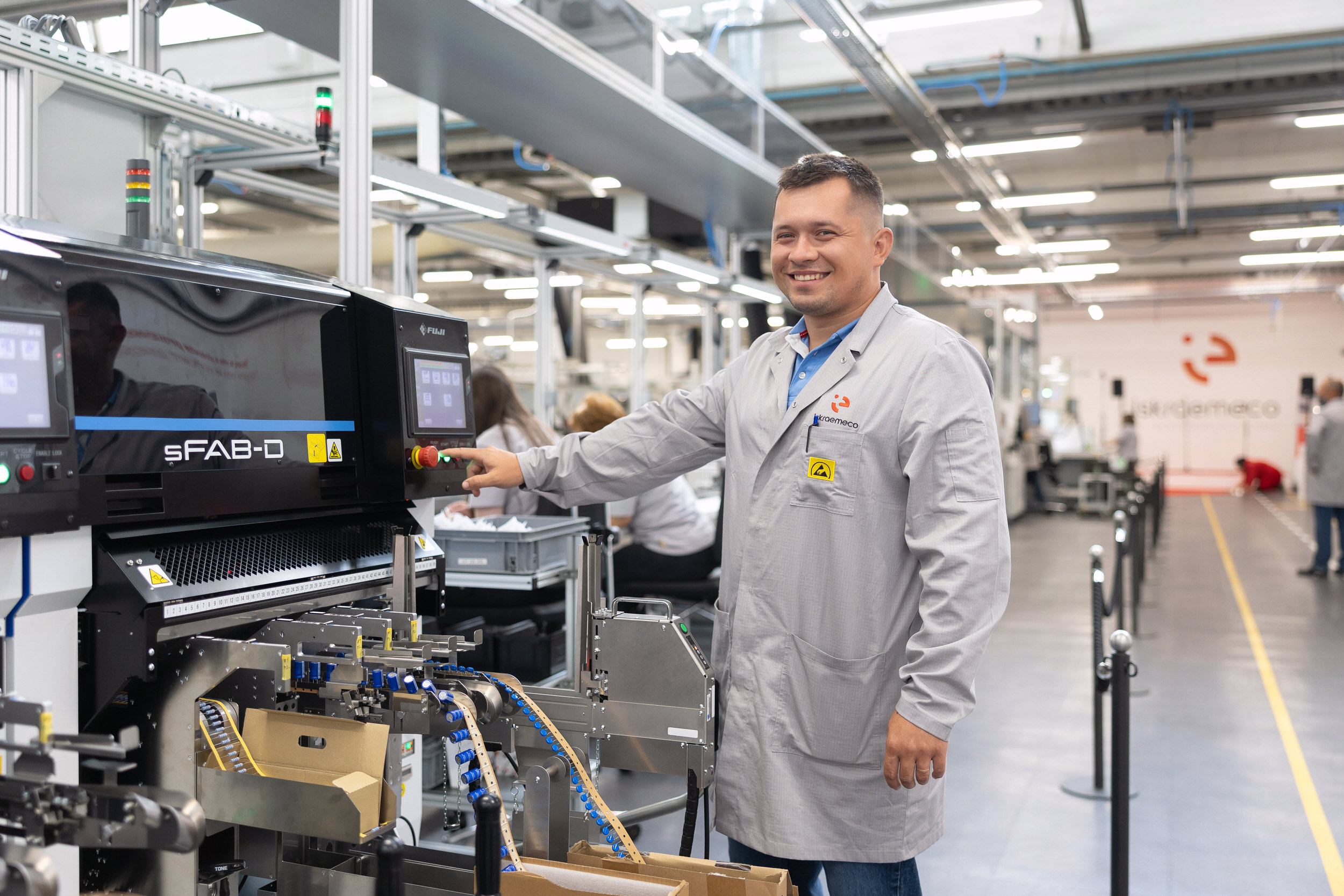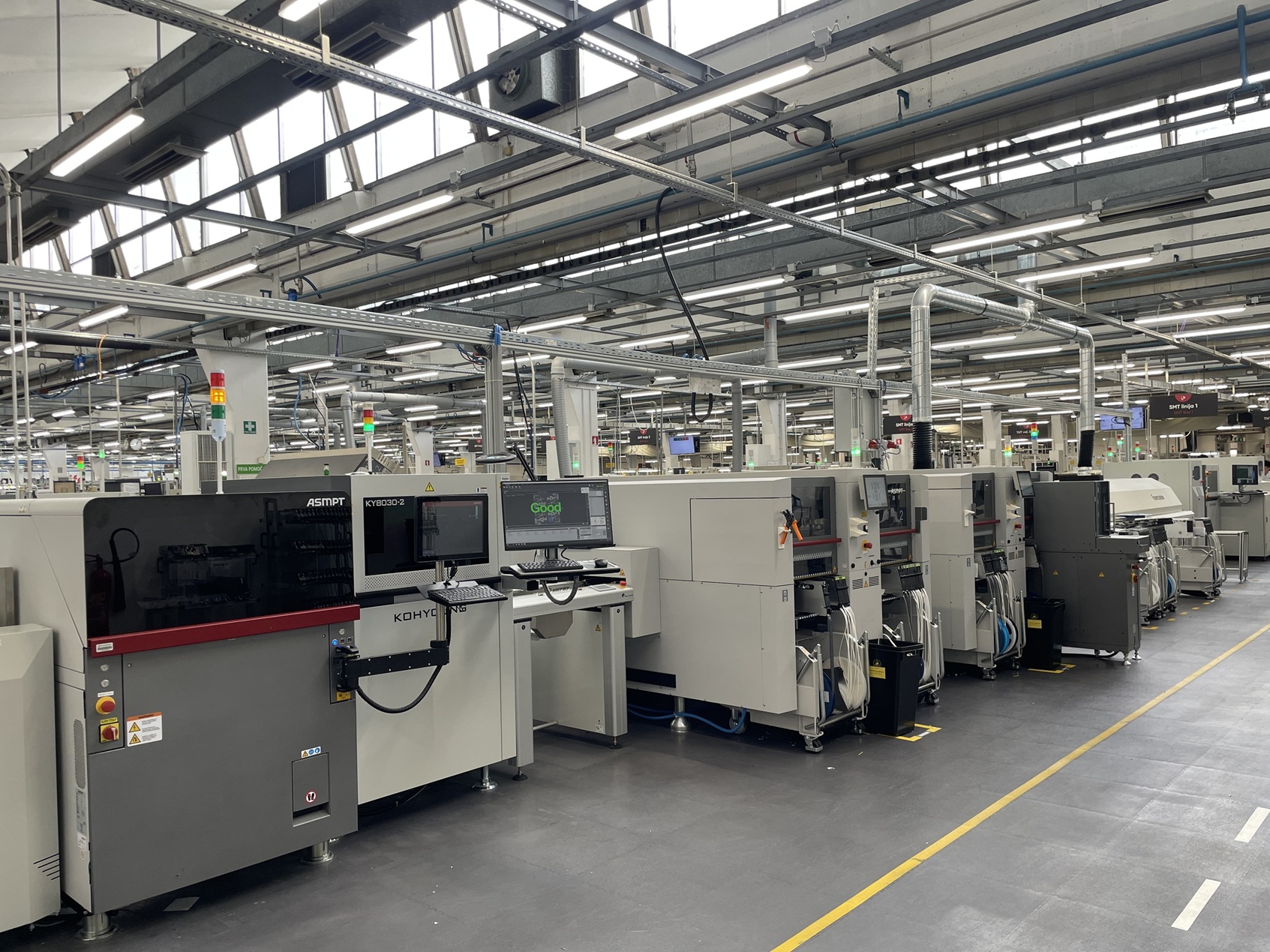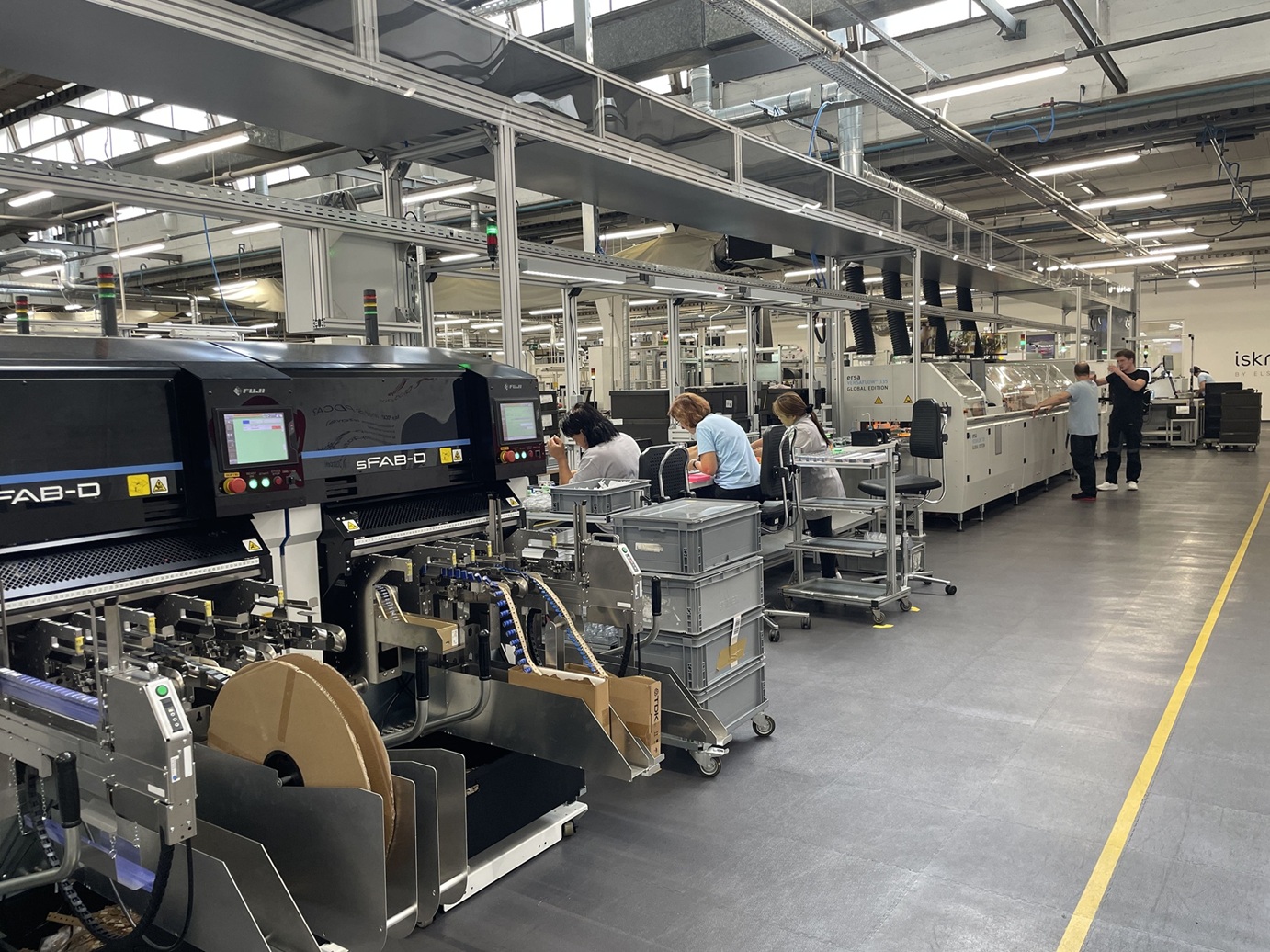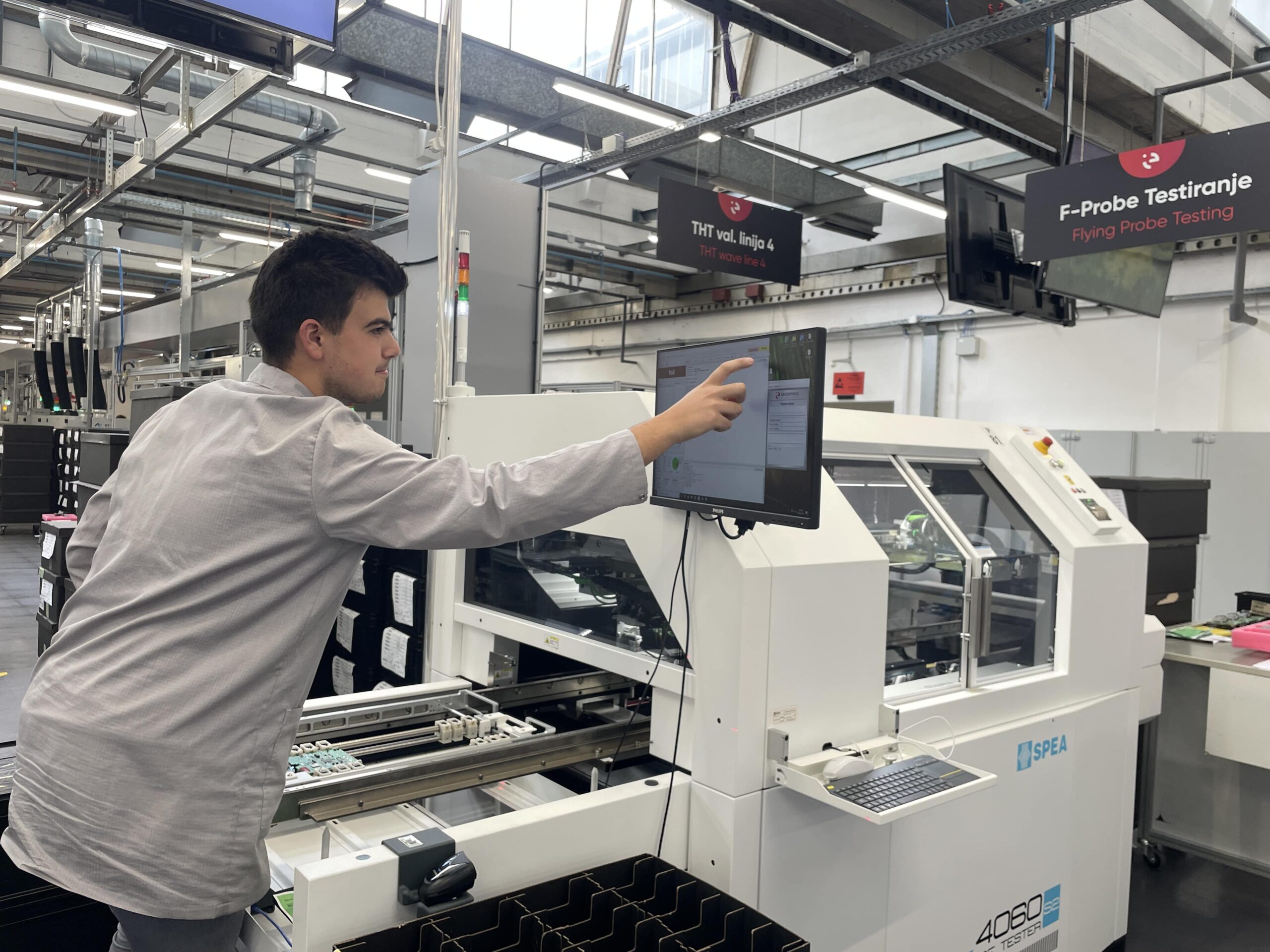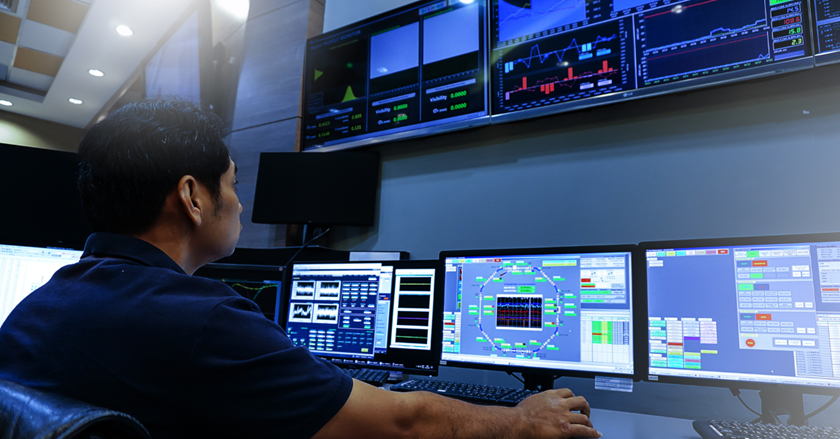New SMT line
The line represents the ultimate combination of speed, precision and smart automation. With the latest equipment, we have created an environment where technology meets efficiency – and the results are remarkable. The new SMT line has the capacity to lay 100,000 components per hour, allowing for as much as 60% faster production compared to IE’s existing SMT lines, with individual hardware being state-of-the-art technology. The SMT line is equipped with the following components:
- The beginning of the line is marked by Solder paste printer, which provides extremely accurate printing of solder paste with minimal deviations. The system is designed for high throughput and enables full traceability of the printing process, which is crucial for the quality of the final product.
- Right behind the printer is the SPI (Solder paste inspection), which uses 3D optical technology to check the quality of the paste application. The system uses advanced algorithms to analyze the volume, height and distribution of the paste and allows for immediate adjustments to the process. The result is complete control over the start of the SMT process.
- The core of the SMT line is represented by Pick&Place machine, which enable extremely fast and precise placement of components. The configuration with different heads (CP20P2, CPPL/TH/CPPH*) and the WPC6 conveyor system enables the processing of the most demanding circuits with high component density. The SIPLACE platform is known for its reliability, flexibility and the ability to quickly change batches, which is crucial for modern production.
- Soldering is handled by Reflow Oven, which represents the next generation of heat treatment. The system enables precise control of temperature profiles, which ensures optimal solder joints without thermal damage to components. CENTURION is designed for energy efficiency and process stability even for the most demanding products.
- At the end of the SMT line is the AOI which allows for a 3D inspection of every joint and component with its ultra-high speed and accuracy. The system uses artificial intelligence to automatically identify errors and optimize transparent parameters. This ensures that only flawless products come from the line, ready for further processing or delivery to the customer.
New THT line
In our company, we have made an important step forward in the development of production capabilities by establishing a new THT line, which combines the most advanced technologies for automated insertion, selective soldering, optical inspection and functional testing. This strategic investment not only means increasing capacity, but also raising the quality, traceability and flexibility of production to a whole new level. The new THT line is a technologically very advanced line and is intended for mass automated production of PCBA production with an emphasis on quality production of printed materials. Above all, innovations: the use of automatic insertors, ergonomically designed workplaces according to the latest guidelines, selective soldering, the use of machine vision for product quality control, and integrated in-line testing, where products are checked during the production process, which means less manipulation, greater traceability, faster detection of defects and shorter time to final product, as well as greater throughput, shorter delivery times and greater flexibility in the use of order management.
The most technologically advanced technology is integrated on the line, namely:
- At the heart of the start of the line are two automatic THT inserters, which enable extremely precise and fast insertion of a wide range of THT components. Its modular design and high flexibility allow easy adaptation to different products, which significantly increases efficiency and reduces batch change time. FUJI technology is synonymous with reliability and automation, which our production now takes full advantage of.
- This is followed by an selective soldering machine with two configurations, namely a line with 6 independent soldering pots and 3×2 parallel heads. This combination allows for exceptional throughput and flexibility – different products can be processed at the same time, without compromising on the quality of the joints. Selective soldering ensures minimal thermal stress on sensitive components, which is crucial for the long-term reliability of products. In the case of selective soldering, it is especially worth noting that the process of selective soldering is more efficient compared to wave soldering, more precise and also more economical (lower consumption of nitrogen and other energy sources.
- Soldering is followed by an optical inspection of the underside of the circuitry using the advanced AOI system, which uses artificial intelligence to automatically identify defects. The system enables extremely fast preparation of transparent programs, as it analyzes the circuit itself and suggests optimal settings. This means less manual work, greater accuracy and a faster response to changes in production. AI technology really shows its power here.
- To ensure the electrical and functional flawlessness of products, SPEA takes care of the test system, which combines ICT (in-circuit) and FCT (functional) testing. This combination enables comprehensive verification of circuits – from individual components to the entire functionality of the product. SPEA is distinguished by fast switching between programs, high accuracy of measurements and the possibility of complete automation of the test process.
- At the end of the line is the NOFFZ test system, which specializes in functional testing of communication interfaces such as LTE and WmBus. The system enables dynamic configuration of test scenarios, high accuracy of signal analysis and full integration with MES systems for traceability and optimization. NOFFZ is indispensable in the verification of modern devices based on complex communication.
A special feature of the new line is also the use of artificial intelligence in quality control:
- Advanced algorithms enable automatic detection of errors such a, missing elements, bridging, pin hole and other critical errors.
- The system learns from thousands of samples and is constantly upgraded, ensuring extremely accurate and reliable quality control.
New Flying Probe Tester
It is a model SPEA 4060s2 IL – a model with 6 flying probes (4 above and 2 below). Ultra-fast probes can touch points as small as 30 μm and can therefore directly contact the contacts of the smallest components on the plate. The main advantage of a flying probe tester is that they are immediately ready to test any new product. Investing in the Flying Probe tester allows us to have greater control over the quality of printed circuit board assembly, faster and more accurate product testing during development, better testing of smaller product batches and sample testing of circuits in individual manufacturing processes.
Advantages of a flying probe tester
- They can be used to test a wide range of plate sizes and shapes without the need for custom fixtures, making them suitable for prototype testing or small volume production where designs change frequently.
- Unlike traditional testers (BONs), which require expensive custom fixtures, flying probe testers eliminate the need for such fixtures. This reduces setup costs and makes them more cost-effective for small production runs or prototypes.
- They offer fast set-up times compared to needle testers. Because they do not require custom fixtures, they can be quickly programmed and installed, reducing overall testing time and speeding up time to market.
- They are non-invasive, which means that they do not physically touch the printed circuit board during testing. This makes them suitable for testing sensitive components that could be damaged by traditional testing methods.
- They use small probes that can access tight spaces and test fine-step components with high accuracy. This allows complex circuit designs to be thoroughly tested without the risk of overlooking errors.
- They offer advanced debugging capabilities, including real-time monitoring and recording of test results. This allows engineers to quickly identify and fix problems during the testing process.
- They can be adapted to different production volumes. Although they are particularly suitable for small to medium-sized batches, they can also be used in larger production environments.
- They have fewer moving parts and require less maintenance, reducing downtime and maintenance costs.
What are the benefits of the new equipment?
- Higher reliability and quality of products
- Shorter time-to-market
- Less dependence on external partners
- Possibility of faster development of new products
- Reduce costs and increase ROI – automation and AI control replace time-consuming manual reviews
What will change with the introduction of new equipment?
With new lines and equipment, we are not only increasing capacity, but also raising standards – both in production and in understanding sustainable and smart industry. This is an important step towards digitalization and Industry 4.0.
